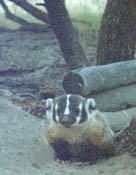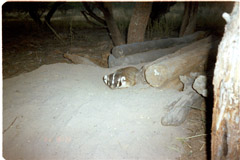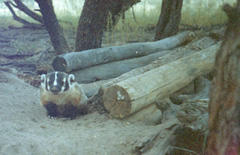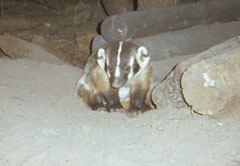 ..
..
Badger (Taxidea taxus)
Badgers are carnivores of the Family Mustelidae, which includes weasels, skunks, and otters. Badgers are most closely related to weasels. Their limbs are short and bear 5 digits each, with very large and heavy, nonretractile, foot-long claws used for burrowing. Our species, the American Badger, is found from British Columbia and Northern Alberta to Central Mexico. The animal's body is very flat in cross-section, with black patches on the face and cheeks and a white stripe extending from the nose rearward to the neck or shoulders (in the Southeastern US, almost to the rump).
American Badgers usually live in relatively dry, open country, often sandy soils, where they dig large burrows for shelter -- or use holes they have previously dug out while hunting (they are mostly active during the night). Their holes are low and wide, 12 X 7 inches, and are not used for long time periods. Badgers are strong, tenacious, and ferocious -- a lone dog is no match for them. They can dig down after prey so rapidly that they can capture rattlesnakes, rabbits, gophers, and kangaroo rats in their holes. They are largely solitary except when breeding.
The Badger shown below was caught with our infra-red camera, in lower Hot Springs Canyon. In the Left photo below, you can see the very large entrance mound (which is typical), and in both the middle and right photos hints of the claws, which are much shorter than those of a full-grown animal. For a closeup of the claws, click on the right-hand photo. While Badgers may reach 25 pounds, this one was much smaller, clearly a youngster, and probably had been recently expelled by its mother. It dug its den in a protected location, beneath the long poles. It seemed to have a very morose demeanor, and remained at this site only very briefly. Click on each of the images below for a close-up.
 ..
.. ..
..
Return to Mammals